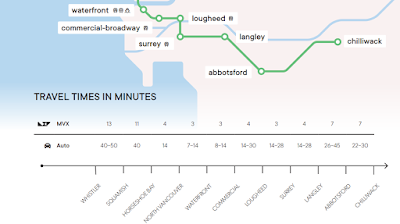One of the things that pops-up from time-to-time is the idea that there are too
many municipalities in Metro Vancouver and the Fraser Valley. The are 27
municipalities in Metro Vancouver and the Fraser Valley. There are 2.9 million
people that live within these municipalities. This works out to one
municipality per 109,000 people.
In the rest of BC, there are 1.6 million people that live within 135
municipalities. This works out to one municipality per 12,000.
Lower Mainland residents are underrepresented when it comes to municipalities
compared to the rest of the province.
One argument about having less municipalities is that it will be more
efficient because of deduplication of services. As I posted about in the past,
duplication is minimal to nil in Metro Vancouver.
The other argument is that some people feel that there are just too many
mayors and councillors.
In the Lower Mainland, people are already underrepresented when it comes to
the number of municipalities. There are 195 people locally elected to councils
in the Lower Mainland. This includes mayors and councillors. This works out to
one municipal representative per 15,000 people overall.
This is not distributed evenly. Langley City has one municipal representative
per 4,000. Abbotsford has one per 18,000. Surrey has one per 64,947.
As
pointed out in a recent CBC article, 48 of BC’s 87 provincial electoral districts are within the Lower Mainland.
This means that there is one MLA per 62,000 people.
Because 62,000 people is a lot of people to represent, each MLA gets a
constituency office. A MLA’s
base salary
is $111,024. Each MLA
also gets $141,400
to hire staff and run a constituency office. It would be impossible to serve
62,000 people on your own. That is a total cost of $252,424, or $4.07 per
person in an electoral district on average in the Lower Mainland.
In Surrey, the mayor has a base salary of $147,019 while a councillor has a base
salary of $74,980. With total salaries of $746,859, this works out to $1.28
per person in Surrey.
In Abbotsford, the mayor has a base salary of $122,379 while a councillor has a base
salary of $46,132. All in, this works out to $3.10 per person in Abbotsford.
In Langley City, the mayor has a base salary of $115,446 while a councillor has a base
salary of $53,874. All in, this works out to $15.83 per person in Langley
City.
Councillors do not get funding for constituency offices.
As someone who is elected in Langley City, I feel that I can keep up with
local issues and have time to meet up with residents to help them. I honestly
don’t know how I would be able to do that if I was elected in a community like
Surrey.
A case could be made to create more municipalities in Metro Vancouver. Surrey
would be a clear example of a community that is under-represented at the local
level.
In the Lower Mainland, there are less municipalities per person than the rest
of the province. There are regional services, and coordination of services
between municipalities. Some of the larger municipalities are underrepresented
at the local level.
While it might look nice on a map to have fewer municipalities in the Lower
Mainland, it would result in less representation than at the provincial level.
Addressing local issues is critical as they have the most impact on people’s
lives. We should be looking to enhance representation, not reduce it.
As a note, Lower Mainland means the Metro Vancouver and Fraser Valley Regional
Districts. The population estimated are for 2019
from BC Stats. All local government salaries are from 2019.













